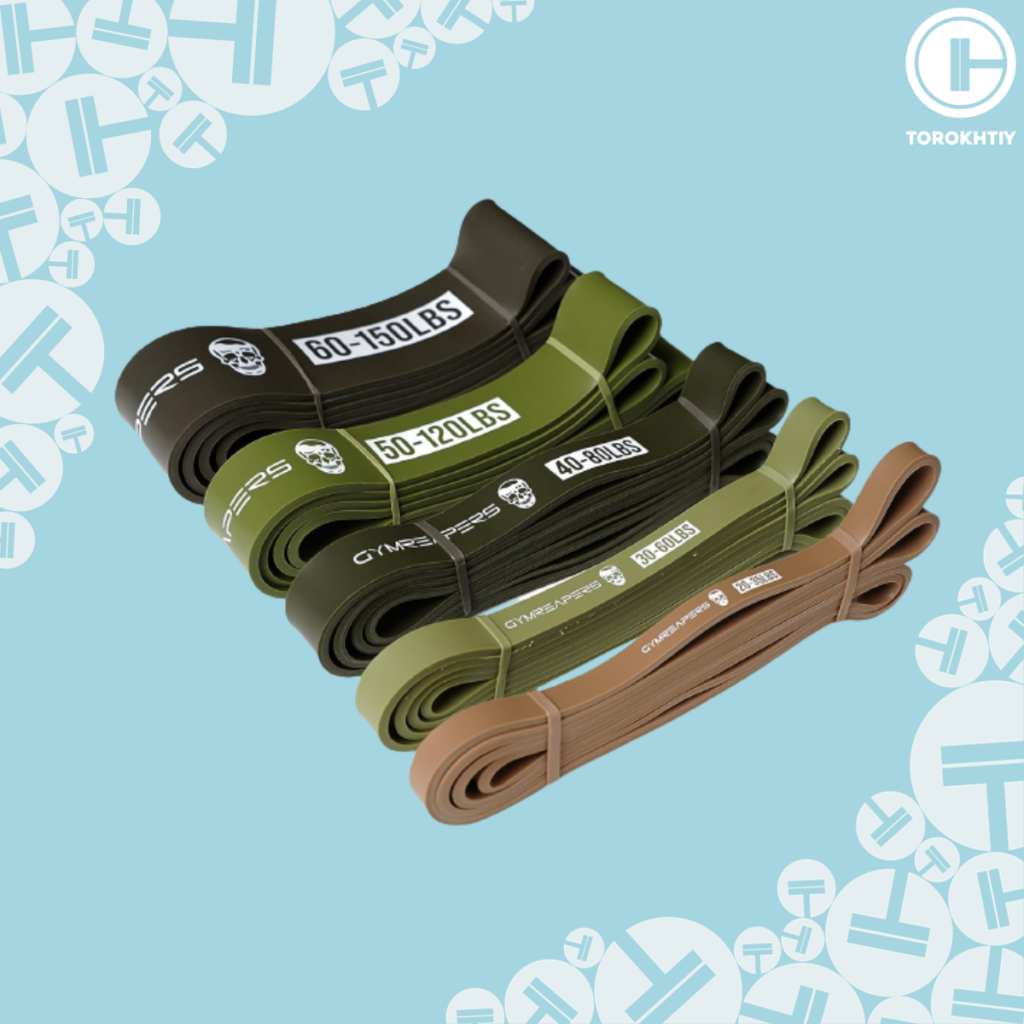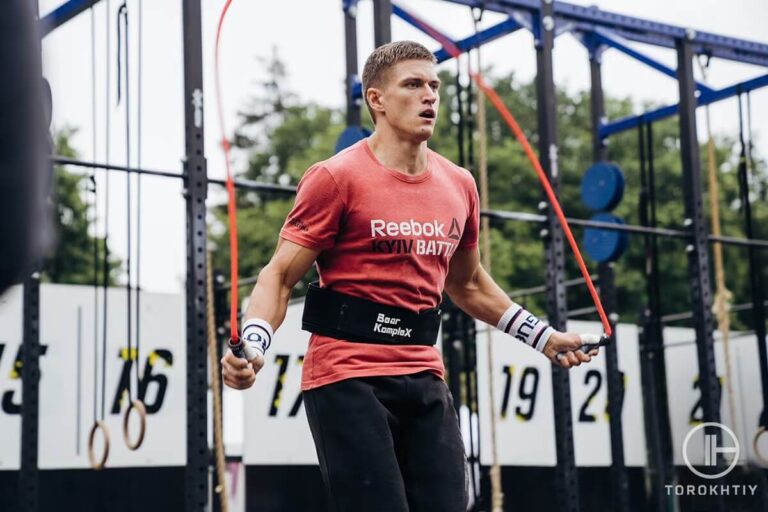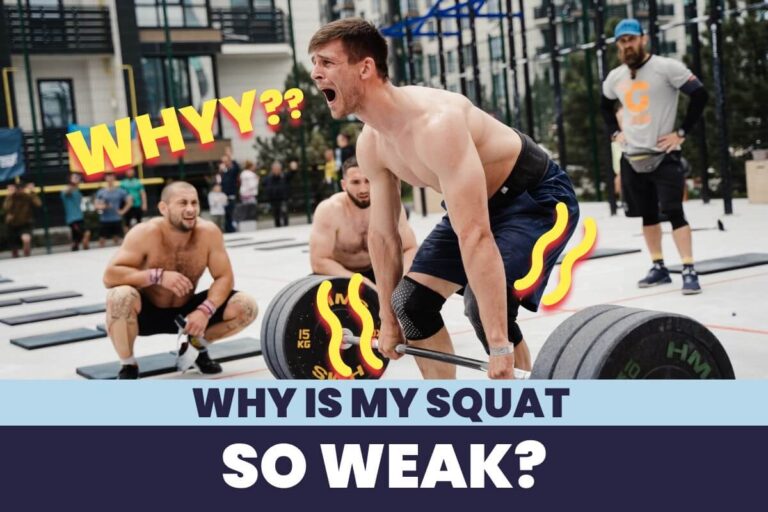Do Resistance Bands Build Muscle? Are They Effective?
Resistance bands have gained remarkable popularity over the years. From being considered a rehab implement to an all-in-one fitness solution, they have rightly found their way to strength training kits.
However, the underlying question remains untouched. Do resistance bands build muscles? You might come across extreme yes-and-no opinions. But a tool’s simplicity doesn’t guarantee its success. We’ll discuss research literature, overlooked facts, and hands-on tips to get you all informed and pumped.
Do Resistance Bands Build Muscle? Resistance band exercises for muscle gain can be quite effective at an early stage of training. Afterward, you should reserve them for warm-ups, functional fitness, and accessory work while relying on free weights to continue the muscle growth.

How do resistance bands work?
Those rubber loops tucked under yoga mats are the least intimidating strength training equipment. They can be pretty useful, too, especially for beginners. The force it takes to stretch a band is, more or less, similar to using free weights or machines. Recent studies have ruled out any difference in muscular gains between elastic and conventional resistance training.
It’s true your body doesn’t discriminate among the sources of resistance. Muscles will continue to grow as long as you can modulate the intensity and duration of load. So, can you build muscle with resistance bands? Sure – up to an extent! When you’re new to the strength game, there is a lot of room for muscle adaptation. After some time, you’ll hit the plateau and have to graduate to weight rooms. Each band comes with a limited range of tension. You can’t increase it like – well – throwing a couple more plates at the end of a barbell.
Exercise-induced muscle hypertrophy depends on three key factors.
- Mechanical tension is the primary force or load placed on muscles.
- Muscle damage is the acute post-workout sensation and soreness.
- Metabolic stress is the accumulation of metabolites at low energy.
Therefore, progressive overloading is the only escalation route for muscle strength and size. The Principle of Progression states that the weekly increase in weight, time, or intensity should be kept within 10% to prevent injuries and developing mass. With gradual increments, you maximize mechanical tension, metabolic stress, and microtears on the cellular level. These driving factors give way to protein synthesis and muscle growth.
If you want to stick with resistance band exercises for muscle gain, you’ll need much tougher ones than those available today. Elastic bands top out at 150-200 lbs. They are a must for any strength-focused exercise regime. You can work small stabilizers and amplify the challenge for larger muscle groups. Furthermore, you can attach bands to classic barbell movements and see your intermediate strength level up. However, any sincere bodybuilding pursuit can’t sideline traditional bells and weights for good.
Advantages of Resistance Bands for Muscle Building
There are various reasons to add elastic bands to your muscle-building routine, whether you’re an underconfident amateur or a ripped gym veteran. They’re less demanding while the performance is on par with alternatives. Let’s look at a few unique benefits of building muscle with resistance bands.
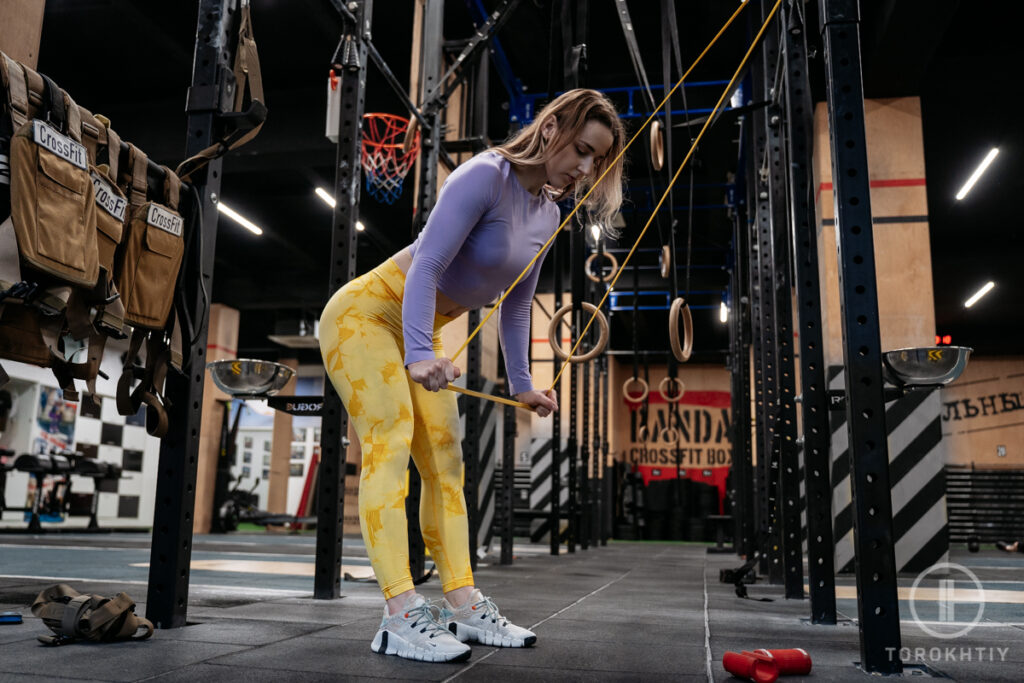
✅ Maximum Time Under Tension
Apart from training load and volume, the time under tension also has a positive relationship with muscle protein synthesis and growth rate. It’s the actual duration a muscle spends under stress.
Think of a bicep curl or lat pulldown and how your body comes to rest during the movement’s eccentric part. Now, perform similar exercises with loop or tube bands, either alone or in conjunction. You’ll have to resist the additional pull through all phases continuously. Bands carry variable resistance. They test your strongest points with the highest tension. Therefore, their training stimulus can sometimes be greater than free weights. And let’s not forget that eccentric contractions result in higher muscle damage (the good type – don’t worry!) than concentric ones.
✅ Stretching and Warm-up
Warm-up is an indispensable training component. You may have seen athletes working different body parts with ROM exercises before a run or drop set. It helps you get into groove and rhythm. It primes your muscles with nutrient-rich blood gushing toward the targeted area. This heightened blood flow improves your exercise performance and reduces injury risks.Although you can’t do bodybuilding with resistance bands only, they’ll remain your trusted companion with warm-ups and cool-downs! For example, lubricate your rotator cuffs on chest days and quads before heavy barbell squats. You can train your endurance, strength, speed, flexibility, balance, or coordination. The most significant benefit of having a good band set is the versatility and variety of possible workouts.
✅ Double Strength Gains
If you want to pack on lean muscles, see bands as a supplement – not a substitute – to weights. The extra bite of resistance besides gravity can wildly explode stability and power gains while changing strength curves. From squats to deadlifts and bench presses to bent-over rows, you can hook bands with bells.A definitive study on the effects of combining resistance training tools was published in the Journal of Strength and Conditioning Research in 2008. Two groups were formed: 1) bands-plus-weights and 2) weights alone. After seven weeks of identical training, they were checked for 1RM back squat and bench press. The improvement for the combined modality was two times greater for bench presses and three times for squats compared to the second group. Furthermore, the average power output also increased threefold.

✅ Incredible Safety and Control
Of all strength training-related injuries, elastic bands pose the least threat. How hard is it to slip out of elongated rubber? Not harder than off-loading 335 lbs from your back, of course! Only latex allergy and mid-workout snapping are issues to look out for. In short, banded exercises are tailored for your strength with easy bailing, low impact, and unparalleled freedom.
Are resistance bands effective for building muscles, after all? The safe and simple nature doesn’t sacrifice the effectiveness. If you can overload, the response is going to be comparable. You can access more ranges and planes of motion. See the curious case of standing chest presses. Dumbbells will sink downward due to gravity, working deltoids more than pecs. Bands anchored horizontally to a post won’t have this problem. Therefore, swimmers and handball players prefer to get some elastic resistance training.
✅ Improved Fitness at Old Age
If you’re considering taking up strength training into retirement years, good for you! Bodybuilding becomes important as we age because of rapid muscle loss after age 60. It might breed other complications in standing, walking, and doing everyday chores. However, you don’t have to lift hundreds of pounds. Resistance band exercises for muscle gain and preservation will do the trick.
There are several upsides to functional fitness. In one study on the senior population, bands were proven to stimulate lower-body strength and flexibility. The markers for general health, pain, and fatigue rebounded altogether. A separate endeavor recorded improvements in grip strength, arm strength, and gross motor skills. Maybe, it’s not that late for crushing those bulky hundos. Remember, elastic bands can help you out with both types of exercises for bone health: weight-bearing and muscle-building.
✅ Ease of Access and Use
The last but not the least advantage of resistance bands is how accessible they are. Skip weight room queues – at least for warm-ups! You can pack them in a bag and hop on international flights without exorbitant fees. Then, hook them to your hotel room’s door knob and squeeze in a quick full-body circuit.
Besides being portable and travel-friendly, they’re inexpensive. Free weights generally set you back around $2 per pound. On the other hand, you can get a good deal on a five-piece band set with 150lb max support. Hence, drawing comparisons between a rack of dumbbells and pocket-size resistive accessories isn’t fair. Considering all the benefits and convenience, it’s wiser to invest small and safe early on. You’ll eventually stock up on other equipment to travel from a beginner to a buff.
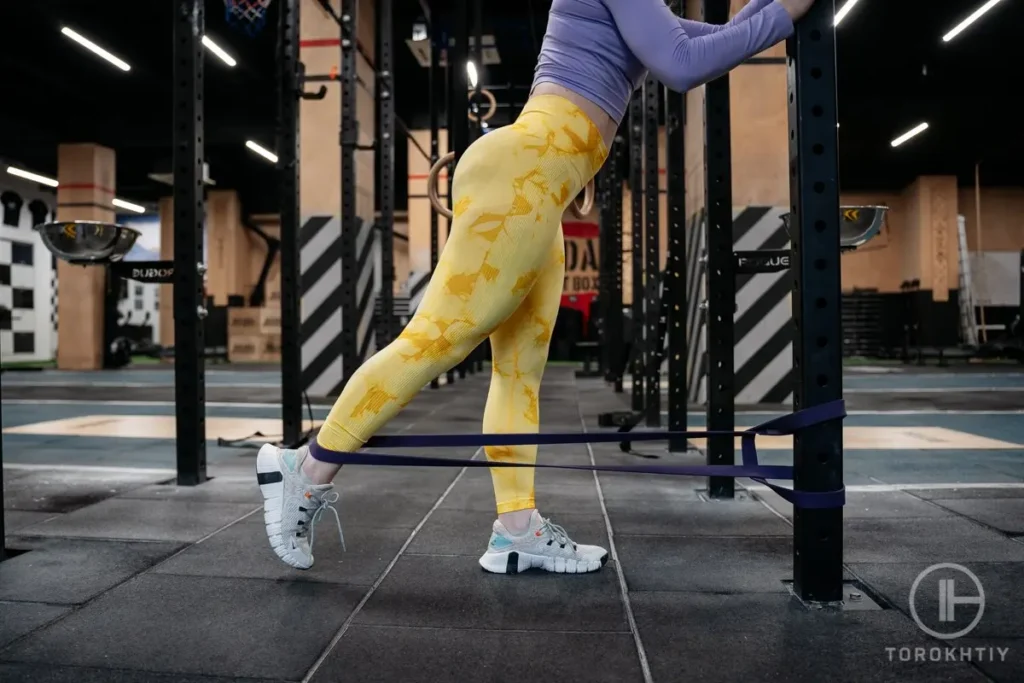
Disadvantages of Resistance Bands for Muscle Building
Free weights are industry-standard for strength training. The maximal gains you can collect using a barbell and a bunch of weight plates are unmatched. Even dumbbells and kettlebells, let alone rubber bands, can’t be central to strength-focused programs. And there are good reasons apart from limited tension.
❌ Difficult to Track
Variable resistance means you’re never sure how much of it is applied at the moment. A 45lb bar weighs the same regardless of the range of motion. However, the tension in a band depends on its thickness, width, and stretch. While building muscle with resistance bands, you can’t jot down the exact poundage in your PR journal. Mind you – quantification is more than a mere motivation factor to push boundaries. It allows you to track and compare day-to-day progress.There is also a phenomenon called the “fatigue of elastic material.” After 500 full stretch cycles, bands lose 9-12% rigidity. Meanwhile, the resistance will get lower with time – another challenge to add to your progression milestones.
❌ Lack of Stability
Your prime movers go all out during fiery, stable training. The inherent lack of stability in surface or equipment recruits core and smaller muscles. We call them stabilizers, fixators, or ancillary muscles. Have you ever wondered how you can lift more with a barbell than dumbbells? With two independent blocks in each hand, your body must do a lot of stabilization, removing the force from the main muscles. Bands are the most unstable.A study compared muscular activity induced by banded and dumbbell flys. As hypothesized, chest engagement was lower. But delts and traps turned super active. Similarly, quadriceps activation is significantly lower during banded squats. Although resistance bands have whole-body functional benefits, you should prefer a quantifiable and stable load for building precise muscle groups.
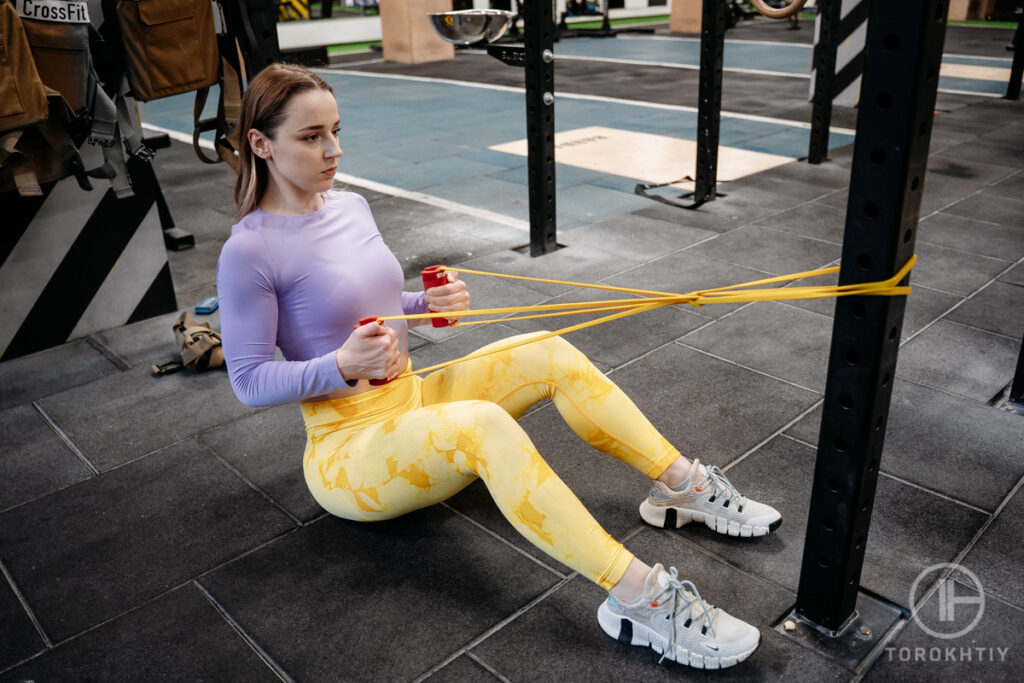
Tips for Successful Muscle Growth with Resistance Bands
1. Maintain the correct form
There is a thing called ego lifting. It may impact your band workouts as well. Focus on the form and movement. Don’t shorten the range of motion or your stance. Otherwise, you’ll compromise the gains. Also, remove any slack in the starting points of bands. They must be stretched out to employ some form of resistance throughout the exercise.
2. Create a customized workout plan
As discussed earlier, you can perform several types of exercises with elastic bands. So, take full advantage. Do warm-ups with lighter bands for 5-6 minutes. Adding a few body weight and flexibility movements will also serve in the long term. Branch your main workouts in both isolated and compound lifts. Bands can assist your pull-ups, too.
3. Train close to failure
Training to failure is a proven method to break plateaus and multiply benefits. However, it can inflict overuse injuries. So, you should devise a rep scheme that pushes you close to failure. In our experience, three or four sets of 6-8 reps are adequate for bigger muscles. Dial down the resistance for smaller muscle groups, and increase repetitions if necessary.
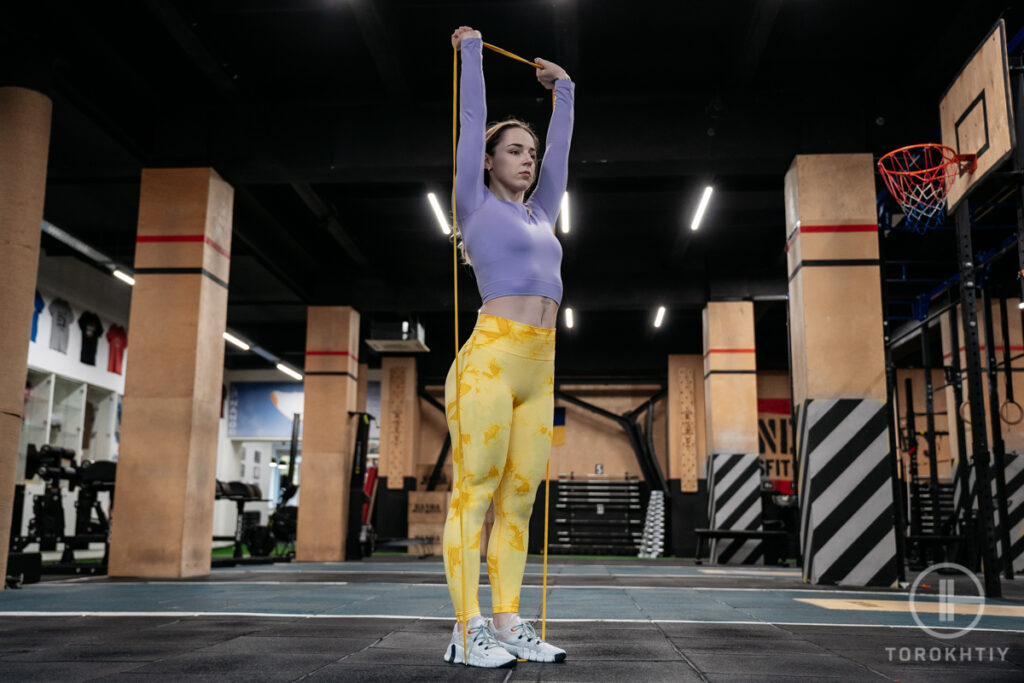
4. Add Intensity to your workouts
Both high-load and low-load training work for muscle-building as long as you’re pushing to failure. However, superior strength adaptation demands load increments. You can increase the frequency of workouts. Or you can choose double or multiple bands to shoot up overall tension. Better yet, bring free-weights into the action; the sooner, the better!
5. Allow plenty of recovery
Muscle building is a simple process. First, you shred muscle fibers with tough resistance training. Then, you supply enough proteins and rest for them to recover – and grow bigger, stronger! Good quality sleep is associated with muscle strength. Also, hydration has a role in power and performance. You get the idea that bulking up warrants a lifestyle change.
Effective Resistance Band Workouts for Muscle Growth
1. Beginner
The benefits of resistance bands for muscle building have finally swayed you. And you have brought a multi-level band set home. Kudos to you! Now start with the most basic exercises.
- Bicep Curl
Isolating biceps is a must-do fitness ritual. Stand in the middle of the band with your normal stance to perform this exercise. Then, pull the band or its handles with an underhand grip up to the shoulder level, keeping elbows at a fulcrum point. Compared to dumbbells, it’s easier on your wrists.
- Overhead Tricep Extension
Stand with one foot forward, the band locked underneath your back foot. Your elbows will be tucked beside your head as you stretch the band overhead and bring it back. Working triceps will refine your lockout strength, which is handy in bench and shoulder presses.
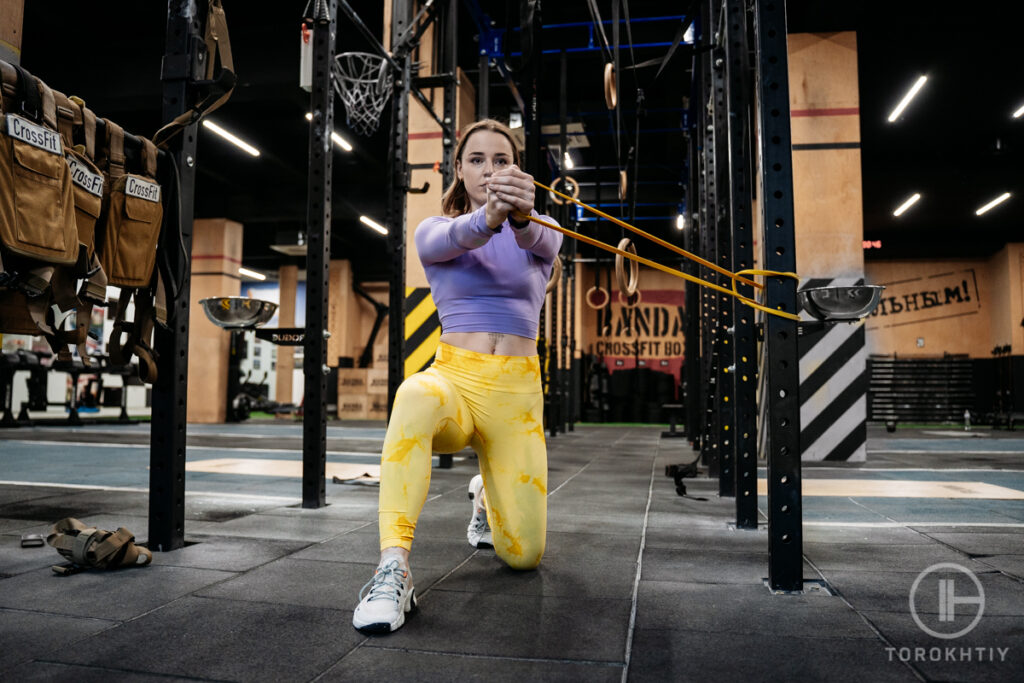
- X Band Walk
X walks will strengthen your glutes and increase awareness, as it’s done in the frontal (side-to-side) plane. You’ll be standing with both feet pressing the band with feet hip-width apart. Create a cross by picking up the right foot loop in your left hand and vice versa. Later, take small steps to one side.
2. Intermediate
Once you’ve garnered strength, look for traditional barbell or dumbbell movements. They’re unavoidable! Simultaneously, make your resistance band workout results more dynamic and intense.
- Band Thrusters
If you’ve performed thrusters with a loaded bar, you know it’s fun. The same can be done with bands and fewer high-impact jerks. Once again, stand in the looped band and get your preferred squatting position. As you reach the rack height of the front squat, kick your hands to the ceiling.
- Bent-over Reverse Flys
Reverse flys and pull-apart are amazing shoulder exercises. But try to pick a few reps with a hip hinge like rowing. This way, you’ll summon back and core muscles in the party. Make an X in front of you and squeeze your shoulder blades. Keep the back and neck parallel to each other.
- Spanish Squats
You’ll need a squat rack or any vertical post to execute this variation. Put the back of your knees into one end while the other is looped around the rack. Go as far as possible, stretching the band fully to enhance knee drive. Do your squat routine. You’ll feel the extra burn in your quads.
3. Advanced
Once you’ve aced the Big 3 lifts, attaching high-resistance bands can bring back the flair. Powerlifters have long prepared with banded deadlifts, squats, and benches to skyrocket strength gains.
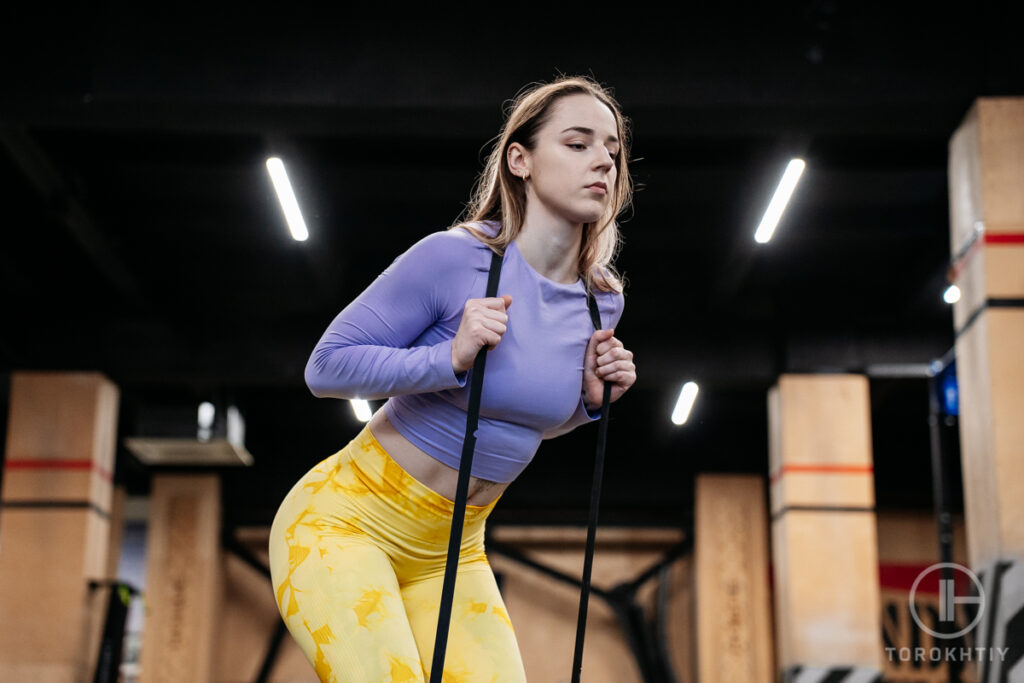
- Romanian Deadlifts
If you feel the bar drifts away or your upper back (lats) remains inactive while deadlifting, attach a horizontal band to the bar. It’ll remind you to keep the bar close. It’s better to do Romanian deadlifts with band resistance as they don’t hurt the lower back.
- Back Squats
The ascending strength curve of squats makes the bottom point most brutal. Bands work contradictory, hence inefficient normally. Combining both maintains the challenge effectively. When you’re low, the weight is difficult to stabilize. As the momentum and leverage increase, the added band pulls you down.
- Bench Press
Bench press follows the same strength curve as squats: easier at the top, harder at bottom. Attach the band to both bar collars while looping it under the bench. Log as many plates as you want. Primary chest muscles won’t have any extra duty, while rear delts and triceps will do overtime.
Choosing the right resistance bands
You can get started with a single resistance band. However, a complete set will cover your workout requirements for a longer period. You may have to switch resistance levels based on training modality, muscles involved, and strength gains. For example, a newbie takes up smaller resistances but heavy assistance for chin-ups.

1. Type of Bands
Bands come in various shapes and sizes. Flat loops are the most common and versatile of them. You can put them around your knees and feet without accessories. Choose a standard length of 40″. The second type is tube bands with handles. They’re best suited for upper-body workouts like triceps extensions, bicep curls, and shoulder presses.
2. Color ID
It’s essential to use the right band. Most are color-coded: yellow (XS), green (S), blue (M), red (L), and black (XL). The rule is not etched in stone. Companies like to play around. If you’re ever dubious, remember that every band set follows a color spectrum, with the darkest being the heaviest. You can also infer the level with the dimensions of the band.
3. Material Quality
The most important thing to ensure is the quality of the material. You wouldn’t like to stretch a band that might break down in the process. Fabric and latex are two frequent materials. The latter is better! Look for multilayered and molded rubber. After all, inspect material health before kicking off each session. Discard any band that shows signs of wear and tear.
4. Accessories
The most straightforward kits throw a bunch of color-coded super bands inside a travel carry pouch. And that’s it! An instructional manual would be a bonus. Keeping workouts simple is universal expert advice. Still, you may lean toward other add-ons like carabiners, handles, wall mounts, door anchors, ankle cuffs, and so on!
Resistance band we recommend
Gymreapers military resistance band set checks off all requirement boxes. Built with robust and lightweight latex, it doesn’t trade quality with portability. These five bands cover a huge resistance range, viz., 20-150 lbs.
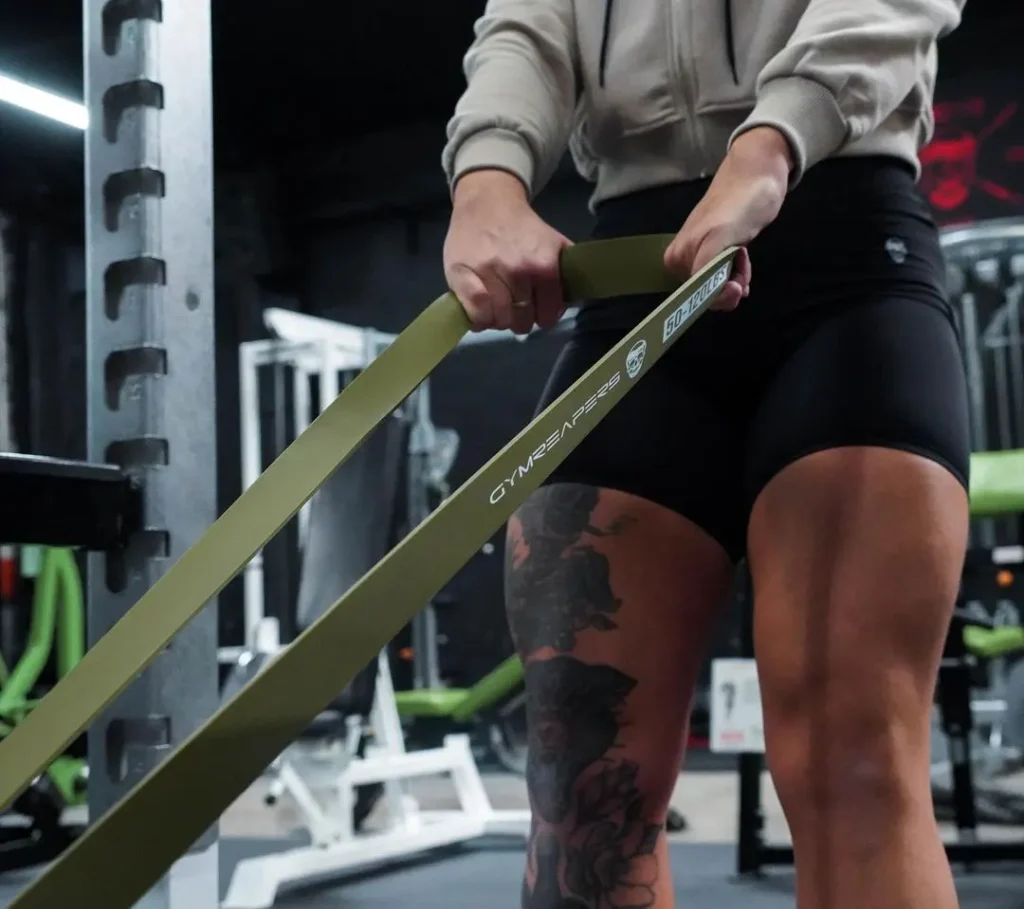
All measure 41” at full length with varying widths. The camouflage color scheme is unusual but aesthetically pleasing. The company sells compatible accessories. Lastly, you can return their products within 30 days of purchase.
FAQ
Can you get big with resistance bands?
If you have no prior training experience, bands might help you gain muscle mass. However, bodybuilding with resistance bands only will create several obstacles in the long term due to tricky overloading and tracking.
Do resistance bands build muscle better than weights?
No! Weights rule muscle-building and strength-training programs. You can use bands to spike your barbell challenges. But in no way will bands be able to keep up with weights in the long term.
Conclusion
Do resistance bands build muscle? A plethora of studies looking at controlled EMG activity and adaptations in muscles might say YES! But no one has ever become a Hollywood hunk pumping latex. There are practical hindrances during progression and periodization. Weight training builds muscle, while bands can help you with warm-ups and accessory work.
Resistance bands are a jack-of-all-trades. They’re valuable for all fitness levels and age groups. They work the body as one unit, polishing a range of physical and mental fitness domains. Strength-building is one of many benefits.
Have you used resistance bands and weights? What’s the difference in feeling between the two? We’d like to see your take in the comment section.
Also read:
- Resistance Band Rows
- Resistance Band Back Exercises
- Benefits of Resistance Bands
- Best Booty Bands
- Resistance Band Lat Pull Down
- Can You Build Muscle With Resistance Bands
- What Size Resistance Bands Do I Need
- Barbell Deadlift With Resistance Bands
- Best Lifting Belts
- Best Resistance Bands
References:
- Jaqueline Santos Silva Lopes et al., “Effects of training with elastic resistance versus conventional resistance on muscular strength: A systematic review and meta-analysis,” SAGE Open Med. 2019; 7: 2050312119831116
- Brad J Schoenfeld, “The mechanisms of muscle hypertrophy and their application to resistance training,” J Strength Cond Res. 2010 Oct;24(10):2857-72
- Nicholas A Burd et al., “Muscle time under tension during resistance exercise stimulates differential muscle protein sub-fractional synthetic responses in men,” J Physiol. 2012 Jan 15; 590(Pt 2): 351–362
- Maxence Rivière et al., “Variable Resistance Training Promotes Greater Strength and Power Adaptations Than Traditional Resistance Training in Elite Youth Rugby League Players,” J Strength Cond Res. 2017 Apr;31(4):947-955
- Alfredo Córdova-Martínez et al., “Effects of Eccentric vs. Concentric Sports on Blood Muscular Damage Markers in Male Professional Players,” Biology 2022, 11(3), 343
- Hyoung-Kil Park et al., “The effect of warm-ups with stretching on the isokinetic moments of collegiate men,” J Exerc Rehabil. 2018 Feb; 14(1): 78–82
- Corey E Anderson et al., “The effects of combining elastic and free weight resistance on strength and power in athletes,” J Strength Cond Res. 2008 Mar;22(2):567-74
- Lavallee, Mark E.; Balam, Tucker, “An Overview of Strength Training Injuries,” Current Sports Medicine Reports 9(5):p 307-313, September 2010
- Elena Volpi et al., “Muscle tissue changes with aging,” Curr Opin Clin Nutr Metab Care. 2004 Jul; 7(4): 405–410
- Mark F. Smith et al., “Effects of Resistance Band Exercises on vascular activity and fitness in older adults,” J Sports Med
- Hernán Ponce-Bravo et al., “Influence of Two Different Exercise Programs on Physical Fitness and Cognitive Performance in Active Older Adults: Functional Resistance-Band Exercises vs. Recreational Oriented Exercises,” J Sports Sci Med. 2015 Dec; 14(4): 716–722
- Guy G. Simoneau et al., “Biomechanics of Elastic Resistance in Therapeutic Exercise Programs,” Journal of Orthopaedic & Sports Physical Therapy, Published Online: January 1, 2001, Volume31, Issue 1: 16-24
- Ronny Bergquist et al., “Muscle Activity in Upper-Body Single-Joint Resistance Exercises with Elastic Resistance Bands vs. Free Weights,” J Hum Kinet. 2018 Mar; 61: 5–13
- Vegard M. Iversen et al., “Multiple-joint exercises using elastic resistance bands vs. conventional resistance-training equipment: A cross-over study,” European Journal of Sport Science, Volume 17, 2017 – Issue 8: 973-982
- Jeffrey M Willardson, “The application of training to failure in periodized multiple-set resistance exercise programs,” J Strength Cond Res. 2007 May;21(2):628-31
- Brad J Schoenfeld et al., “Effects of Low- vs. High-Load Resistance Training on Muscle Strength and Hypertrophy in Well-Trained Men,” J Strength Cond Res. 2015 Oct;29(10):2954-63
- Yanbo Chen et al., “Relationship between sleep and muscle strength among Chinese university students: a cross-sectional study,” J Musculoskelet Neuronal Interact. 2017 Dec; 17(4): 327–333
- Daniel A Judelson et al., “Effect of hydration state on strength, power, and resistance exercise performance,” Med Sci Sports Exerc. 2007 Oct;39(10):1817-24
Why Trust Us?
With over 20 years in Olympic Weightlifting, our team does its best to provide the audience with ultimate support and meet the needs and requirements of advanced athletes and professional lifters, as well as people who strive to open new opportunities and develop their physical capabilities with us.
By trusting the recommendations of our certified experts in coaching, nutrition, dietology, and sports training programming, as well as scientific consultants, and physiotherapists, we provide you with thorough, well-considered, and scientifically proven content. All the information given in the articles concerning workout programming, separate exercises, and athletic performance, in general, is based on verified data. We ensure that you can rely on our professionals’ pieces of advice and recommendations that can be treated as personalized ones which will benefit you and fully meet your needs.
The product testing process is described in more detail here
Author: Ihor Shymechko
Pro Olympic Weightlifter, Coach
Best Results: Snatch – 208 kg,
C&J – 240 kg
Ihor has been a professional weightlifter since 1996, boasting over two decades of competition experience. His notable achievements include clinching the European Championship in 2009 and securing a silver medal in the 105kg division at the Senior World Championships in 2011. Ihor represented his country in the 2008, 2012, and 2016 Summer Olympics. After retiring from competitive weightlifting, he transitioned to coaching, leveraging his vast experience to guide athletes who now compete on both national and international stages.

